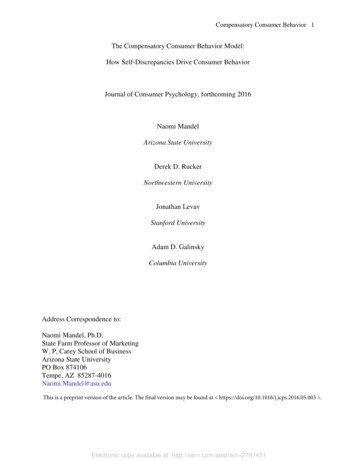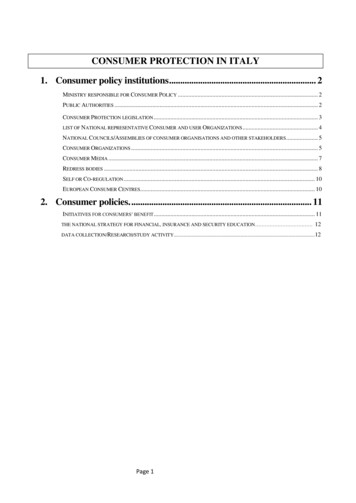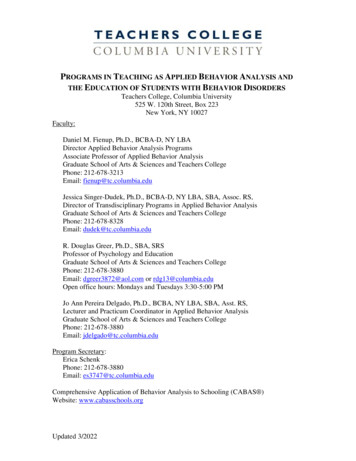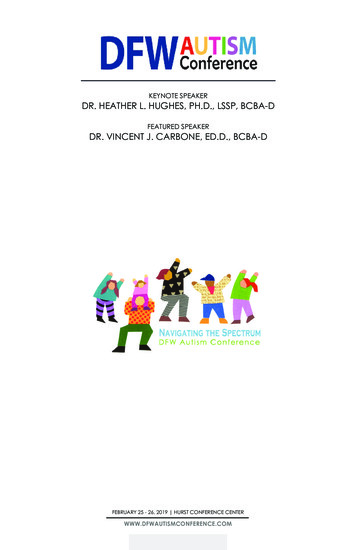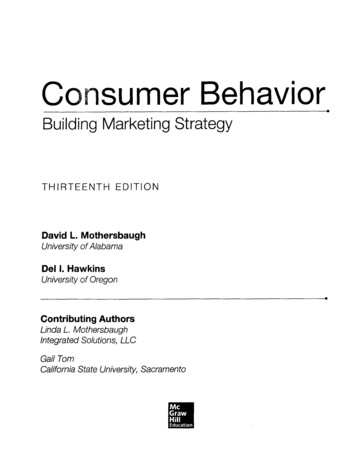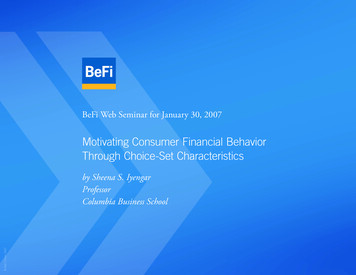
Transcription
BeFi Web Seminar for January 30, 2007Motivating Consumer Financial BehaviorThrough Choice-Set Characteristics BeFi Forum 2007by Sheena S. IyengarProfessorColumbia Business School
Motivating ConsumerFinancial BehaviorThrough Choice-SetCharacteristicsSheena S. IyengarColumbia University Business School
About MeEducation PhD in Social Psychology, Stanford University 1997 Undergraduate: University of Pennsylvania BS Economics, Wharton School of Business - 1992 BA Psychology, College of Arts & Sciences – 1992Awards and Honors Presidential Early Career Award Full Grant, Citigroup Behavioral SciencesResearch Council Invited Fellow, Institute for Advanced Studies,Princeton
My Research InterestsWhat are the consequences whenpeople face choice sets with increasingnumbers of options?How does it affect people’s Decision quality Satisfaction with choices made
Choice Then and Now
New York Stock er of Companies ListedIncrease in Options andCombinations of OptionsNumber of Mutual 01940 1945 1950 1955 1960 1965 1970 1975 1980 1985 1990 1995 2000
6 Jams
24 Jams
More Choice: AppealingBut DebilitatingNumber of people whoACTUALLY BOUGHT6 JAMS24 JAMSGraphics source:Simon Fraser,Fidelity International
What if choosers are givenincentives for choosing?Consider retirement savingsprograms in which notchoosing is financiallydetrimental
Vanguard DataIndividual-Level CharacteristicsNumber of employees793,794Participation rate71%Average contribution 3,848Max out rate12%Median annual income 47,430Gender distribution63% maleMean age42 yrs
Vanguard DataPlan-Level Characteristics124 include companystock as an option647 Plans47 match in companystock only316 offer Defined Benefitplans2-59 Funds Offered90% offer between 6 and22 funds18 offer more than 30funds
The Effect of Choice onSavings Behavior75%70%65%60%55%# Funds dicted Participation80%
10 Funds Money MarketPercent Change in Allocation108%6420-2Allocation toCash FundsProbability ofAllocating Morethan 50%
10 Funds Money Market & BondPercent Change in Allocation108%642012Allocation toCash &Bond FundsProbability ofAllocating Morethan 50%
10 Funds - EquityAllocation toEquity Funds0Probability ofAllocating to EquityFunds-2-4%-6-8-10-12-14Percent Change in Allocation
Asset Allocation Participants generally allocated theircontributions to 3 or 4 funds,regardless of the number in their plan Allocated evenly between plans – the“conditional 1/N rule” Allocation to equities did not increasewith number/proportion of equity fundsin planHuberman and Jiang, Journal of Finance April 2006
Choosing From 3 GamblesThank you for participating in the experiment. For compensation, pleaseselect one of the gambles below. The experimenter will then flip a coin.Should the coin land on “heads,” you will receive the amount specified inthe left column. Should the coin land on “tails,” you will receive theamount specified in the right column. Please check off the desiredgamble and the experimenter will proceed to flip the coin.Please place acheck next to thedesired optionIf the coin indicates“heads”If the coinindicates “tails” 5.00 5.00 13.50 0.00 8.75 3.50
Choosing From 11 GamblesPlease place acheck next to thedesired optionIf the coinindicates“heads”If the coinindicates “tails” 4.00 8.25 11.75 1.00 5.00 5.00 4.50 7.75 1.50 11.25 13.50 0.00 8.75 3.50 9.50 3.00 12.50 0.50 2.50 10.00 10.50 2.00
Effect of Choice Set Size onGamblingGamble Chosen by Participants (%)Low ChoiceHigh Choice80706050403020100Sure BetRisky Gamble
3 Gambles, 6 Payoffs EachThank you for participating in the experiment. For compensation, pleaseselect one of the gambles below. The experimenter will provide you witha die. You will cast the die and, depending on how the die falls, receivethe amount of money indicated in the table below. Please check off thedesired gamble.Pleaseplace acheck nextto thedesiredoptionIf thediefalls on1, youreceiveIf thediefalls on2, youreceive 0.00 0.00If thediefallson 3,youreceive 0.00If thediefallson 4,youreceive 10.00If thediefallson 5,youreceive 10.00If thediefallson 6,youreceive 10.00 9.25 7.00 0.75 8.75 1.25 1.50 9.75 8.50 0.75 0.00 4.25 5.50
11 Gambles, 6 PayoffsEachPleaseplace acheck nextto thedesiredoptionIf thediefalls on1, youreceiveIf thediefalls on2, youreceiveIf thediefalls on3, youreceiveIf thediefalls on4, youreceiveIf thediefalls on5, youreceiveIf thediefalls on6, youreceive 7.00 1.50 9.25 0.75 8.75 1.25 4.25 5.50 0.00 8.50 0.75 9.75 1.00 2.00 6.75 7.50 5.75 4.75 0.00 0.00 0.00 10.00 10.00 10.00 5.50 7.50 0.75 6.75 1.00 6.50 9.75 8.00 0.00 0.00 2.75 8.75 3.00 1.50 6.50 9.75 7.00 0.50 3.25 1.50 1.50 2.50 9.50 10.00 3.25 8.50 5.50 8.50 0.00 2.50 3.75 7.75 2.00 9.25 3.25 2.00 1.25 0.75 4.50 8.75 4.50 8.50
Gamble Chosen by Participants (%)Preference for the BinaryGamble6050403020100Low ChoiceHigh Choice
Branching OutFuture research need not be limited to401(k) plans, but could include Mutual funds Lending Insurance Credit cards
Further DirectionsConsumer Choice Over Time Does choice overload have a persistent ortemporary effect on participation rates? What effect does increasing or decreasing thenumber of funds in a plan have on consumerbehavior? Data requirements: Multi-year data oncustomers’ decisions, ideally longitudinal
Further DirectionsOption Presentation As the number of options rises, whichattributes remain/become predictive ofconsumer choice? Order of presentation Clarity Similarity or distinctness from other options Data requirements: Choice data linkedto arrangement and characteristics ofchoice-set items
Further DirectionsOptimal Number of Options What number of options results in the highestconsumer participation? How does this number vary by Domain (e.g. mutual funds vs. insurance policies vs.insurance policies) Customer (e.g. age, expertise) Time horizon (e.g. short-term vs. mortgage loans) Data requirements: Data on a variety ofproducts/services, or could be addressedthrough field studies and questionnaire data
Further DirectionsMultiple-Domain Choice Interaction How do choices in one domain (e.g.mutual funds) affect choices made inanother (e.g. insurance policies)? Are people consistent across domainsin their responses to choice? Data requirements: Data fromproviders of comprehensive financialservices
Questions?
Contact InformationUntil June 2007PermanentOrganizational Behaviour A303London Business SchoolRegent's ParkLondon NW1 4SAUnited KingdomUris Hall 714Columbia University Business School3022 BroadwayNew York, NY ard: 44 (0)20 70007000Direct line: 44 (0)20 7000 8931Extension: 8931Phone: (212) 854 8308http://www.columbia.edu/ ss957
Columbia Business School BeFi Forum 2007. Motivating Consumer Financial Behavior Through Choice-Set Characteristics Sheena S. Iyengar Columbia University Business School. About Me . The experimenter will then flip a coin. Should the coin land on "heads," you will receive the amount specified in the left column. Should the coin land on .

